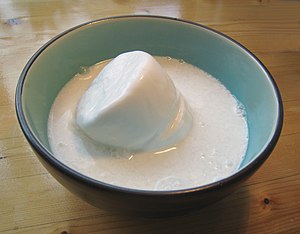Ingredients;
- 2 Chicken legs with thigh attached
- 150 grams Oyster mushrooms
- 100 grams Dton Kha (Galangal)
- 3 Lemon grass stalks
- 2 bushels of Coriander (Cilantro)
- 2 coriander roots (use the root of the bushels)
- 5-6 Kaffir Lime leaves
- 3 or 4 Kaffir Limes
- 20 Prik Khee Hnuu (Thai chilies)
- 1 cup of Hua Kati (Coconut juice)
- 1 cup of Hang Gati (Coconut cream)
a little fine grain sugar
- 1 Tbsp Nam Pla (Thai fish sauce)
- 1 cup of Water to dilute the coconut when cooking
Alternatives;
Some people like to add tomatoes to the soup too, which works quite well, giving a more acrid and acidic tinge to the taste of the coconut milk.
Instead of Oyster mushrooms, you could add Straw mushrooms or dried Chinese or Shiitake mushrooms to the soup instead. In such a case you must soak the dried mushroom in hot water for about 20 minutes first before adding them.
This soup works with Chicken, Fish and Seafood such as Crab, Squid or Shrimp (or even all three) too.
I suppose you can make it with Pork but i have never seen Thais use Pork for this recipe, nor Beef for that matter. White meats are of course milder which doesn't overpower the soft flavours of the Coconut and Galangal
Preparation Method;
Take the Chicken thighs, clean and chop them into smaller pieces on the bone (if you don't like Chicken on the bone you can fillet it, but Thai people prefer meat on the bone as it has more taste).
ฟังวิทยุออนไลน์ ที่ izeemusic
Then take the Lemon Grass (Thakrai - ตะไคร้), and slice it diagonally, after pounding it slightly in the same way as the Coriander (Pak Chee - ผักชี).
Left pic - Product from Amazon.com
6 Fresh Lemon Grass stalks from tastepadthai
6 stalks medium size of fresh lemon grass guaranteed to arrive fresh
If you are not 100% satisfied with the product quality upon arrival, we will replace at no additional charge.
Fresh produce, premium quality products from TastePadThai.com
Price: $5.50
Buy now; Instant Coconut Soup (Tom Kha) Makes 4 Cups or 2 Bowls
Then lower the heat for it to simmer lightly. keep stirring all the time to prevent the Coconut milk from becoming lumpy. Once it has begun to simmer, add the Chicken meat and bring back to simmering point.
Taste the soup to check how salty it is, and add some Thai fish sauce (Nam Pla - น้ำปลา) to taste (perhaps one tablespoon might suffice).
Now is the time to add the Oyster mushrooms; Please check and taste the soup a few minutes after they have simmered a little in the soup, as Oyster mushrooms tend to release water when they are cooked, which may cause the soup to lose some saltiness. Add more fish sauce or salt if necessary if this is the case.

Squeeze the kaffir Limes to extract the juice and keep in a aucer or small bowl with the chillies (point the chillies slightly in a pestle and mortar or with a meat hammer, or even the base of a cup if you don't have these things). Some people will add the Lime juice and chillies before closing the lid of the pan and simmer along with the soup, but those in the know will not do this as it will make the soup bitter and even separate the coconut juice from the milk. So i recommend that you keep thie juice and chillies aside till the end and add it slightly before serving the soup
here is what the soup should look like now; serve in a bowl and sprinkle some Coriander on the top as an aromatic and colorful decoration to your Tom Kha Gai!
.
Alternative versions;
Here are some pics of the various alternative styles with varied ingredients made by different cooks, so you can see that in Thai cookery, no two people make things exactly the same. So you shouldn't worry too much about recreating an identical copy as far as appearance is concerned. The version above is however, what i would call the classic reference model for Tom Kha Gai.
Thanks to; Krua Klai Baan and Thai Cook Mae Slim , Cooking by May for pics

Pla Salid is called Damsel Fish or Snakeskin Gourami in English. In Thailand, we like to place the fish out to dry a few hours in the sun rubbed in salt, and then fry them. This fish is one of my favourites especially in "Yam Pla Salid" (Thai lemony salad with crispy fried Damsel Fish). I shall be posting this recipe with some mouthwatering pics in my next post soon.
Left Pic; Damsel Fish, or Snakeskin Gourami
(Trichogaster pectoralis)
PLA SALID (TRICHOGASTER PECTORALIS REGAN); A LIFE HISTORY AND MANUAL FOR CULTURE
Interesting links;
Taxonomy link for Coriander
Taxonomy link for Lemon Grass






























































